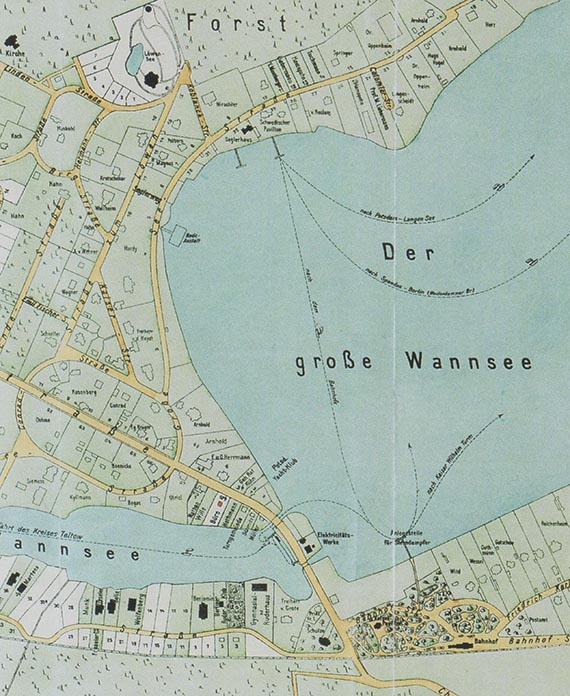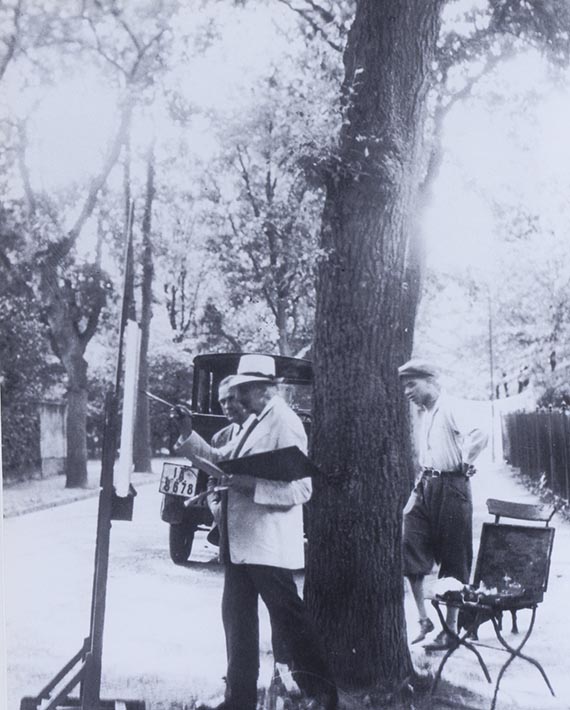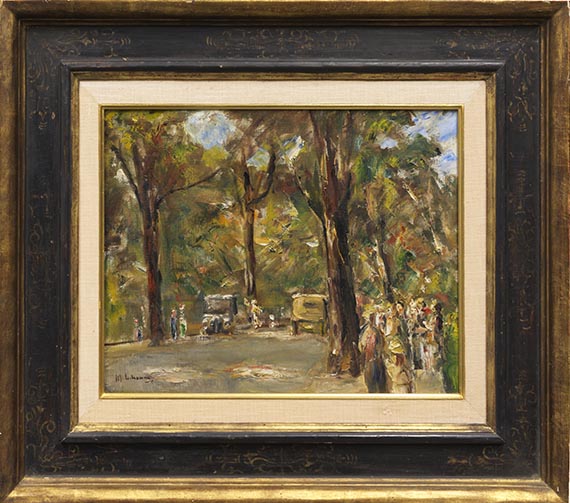Video
Frame image
13
Max Liebermann
Allee mit Spaziergängern und Automobilen, 1924.
Oil on canvas
Estimate:
€ 350,000 / $ 413,000 Sold:
€ 571,500 / $ 674,370 (incl. surcharge)
Allee mit Spaziergängern und Automobilen. 1924.
Oil on canvas.
Signed in the lower left. With fragments of a label inscribed with the number "2122 / 02" on the reverse. 41 x 50.5 cm (16.1 x 19.8 in).
[KT].
• The vibrant "Große Seestraße in Wannsee" is one of Liebermann's most prominent motifs.
• Liebermann's works from the 1920s are among the most popular ones on the international art market.
• Movement, light, and shadow, captured in a dynamic style and vibrant colors, make the works from the 1920s a highlight of Liebermann's oeuvre.
• Comparable paintings can be found in significant collections such as the Nationalgalerie Berlin, the Kunsthalle Hamburg, the Kunsthalle Bremen, the Gemäldegalerie Neue Meister, Dresden, the Niedersächsische Landesmuseum, Hanover, and the Museum Wiesbaden.
PROVENANCE: M. Goldschmidt & Co., Frankfurt am Main (until 1931).
Max Wolf (1887-1948), Schlüchtern/Lancashire (acquired from the above in 1931, until 1948).
Gerald Victor Wolf (1919-2003), Disley (from the above, until 1987: Sotheby's).
Gemälde-Cabinett Unger, Munich (1988).
Private collection, North Rhine-Westphalia.
EXHIBITION: Max Liebermann - Carl Hagemeister, Gemälde-Cabinett Unger, München, 1988, no. 43.
LITERATURE: Matthias Eberle, Max Liebermann. 1847-1935. Catalogue raisonné of paintings and oil studies, vol. II: 1900-1935, Munich 1996, p. 1123, no. 1924/42 ( illustrated).
--
Sotheby's, London, Nineteenth Century European Paintings, Drawings and Watercolors, November 25, 1987, lot 306.
Holly Prentiss Richardson, Landscape in the work of Max Liebermann, Phd thesis. Brown University, Ann Arbor 1991, Vol. II, p. 250, no. 713.
Sotheby's, Berlin, November 27, 1992, lot 5 (illustrated).
Auktionshaus Lempertz, Cologne, Moderne Kunst, May 29, 1999, lot 876 (illustrated).
"The wisdom of spatial representation in this small street scene is tremendous! It draws the viewer into the green street vault to experience the space."
Karl Scheffler, in: Kunst und Künstler, vol. XXII, 1924, issue 10, p. 291
Oil on canvas.
Signed in the lower left. With fragments of a label inscribed with the number "2122 / 02" on the reverse. 41 x 50.5 cm (16.1 x 19.8 in).
[KT].
• The vibrant "Große Seestraße in Wannsee" is one of Liebermann's most prominent motifs.
• Liebermann's works from the 1920s are among the most popular ones on the international art market.
• Movement, light, and shadow, captured in a dynamic style and vibrant colors, make the works from the 1920s a highlight of Liebermann's oeuvre.
• Comparable paintings can be found in significant collections such as the Nationalgalerie Berlin, the Kunsthalle Hamburg, the Kunsthalle Bremen, the Gemäldegalerie Neue Meister, Dresden, the Niedersächsische Landesmuseum, Hanover, and the Museum Wiesbaden.
PROVENANCE: M. Goldschmidt & Co., Frankfurt am Main (until 1931).
Max Wolf (1887-1948), Schlüchtern/Lancashire (acquired from the above in 1931, until 1948).
Gerald Victor Wolf (1919-2003), Disley (from the above, until 1987: Sotheby's).
Gemälde-Cabinett Unger, Munich (1988).
Private collection, North Rhine-Westphalia.
EXHIBITION: Max Liebermann - Carl Hagemeister, Gemälde-Cabinett Unger, München, 1988, no. 43.
LITERATURE: Matthias Eberle, Max Liebermann. 1847-1935. Catalogue raisonné of paintings and oil studies, vol. II: 1900-1935, Munich 1996, p. 1123, no. 1924/42 ( illustrated).
--
Sotheby's, London, Nineteenth Century European Paintings, Drawings and Watercolors, November 25, 1987, lot 306.
Holly Prentiss Richardson, Landscape in the work of Max Liebermann, Phd thesis. Brown University, Ann Arbor 1991, Vol. II, p. 250, no. 713.
Sotheby's, Berlin, November 27, 1992, lot 5 (illustrated).
Auktionshaus Lempertz, Cologne, Moderne Kunst, May 29, 1999, lot 876 (illustrated).
"The wisdom of spatial representation in this small street scene is tremendous! It draws the viewer into the green street vault to experience the space."
Karl Scheffler, in: Kunst und Künstler, vol. XXII, 1924, issue 10, p. 291
In 1914, Dr. Otto Schneider reported about his visit to Max Liebermann at his Wannsee home in the magazine "Die Dame," the then world's most exclusive illustrated women's magazine published by Ullstein between 1911 and 1943 and regarded as the "leading gazette for fashion issues." Schneider was amazed by the high profile that the painter enjoyed even among cab drivers: "When I told the chauffeur at Wannsee station the address, he smiled and replied proudly: To Professor Liebermann?" (in Die Dame, summer issue, August 1, 1914, issue 21, pp. 2-4). And so the editor rides from Wannsee station along Große Seestraße, past stately mansions on ample plots of land, before turning right into Colomierstraße, actually a little dead-end street, with the painter's villa and garden immediately on the right.
Max Liebermann acquired this expansive plot of land directly on the shores of Wannsee in 1909. In the months that followed, he not only had a prestigious summer residence built, but he also laid out a magnificent garden with flowerbeds, a birch grove, and a jetty, as well as a gardener's house with a flower and vegetable garden facing the Große Seestraße. When designing the flower and vegetable beds, the painter sought advice from the then Berlin Garden Director Albert Brodersen and his friend Alfred Lichtwark, the Director of the Hamburg Kunsthalle. The play of light and shadow in the trees and the vibrant colors of the flowers provided Liebermann with a wealth of motifs for his paintings. After spending the summer months before the First World War on the Dutch North Sea coast, Max Liebermann would concentrate on the surroundings of his studio on Pariser Platz, with the avenues in the 'Tiergarten,' just a few steps from his townhouse, serving him as colorful motifs, just as much as the surroundings of his summer house on Wannsee, the garden and the 'Große Seestraße.'

Our painting shows a long, broad avenue bathed in light, with people in summer attire strolling along and two cars parked or moving in opposite directions. Große Seestraße (today 'Am Großen Wannsee') was a popular day-trip destination for Berliners and led directly past Liebermann's garden. The street offered him an excellent backdrop for his lavish paintings, flooded with light and full of gestural temperament. A contemporary photograph shows the artist with an easel, painting utensils, and onlookers on Colomierstrasse, probably on the corner of Grosse Seestrasse. Liebermann usually painted in the middle of the action, and it seems he had also set up his easel at the curb of the avenue for the present painting. A self-assured attitude like this reflected the character and aspirations of the French plein-air painters who had inspired Liebermann since his stay in Paris in 1874. He immersed himself in the lightness and cheerfulness of their paintings, studying and acquiring them over the years and amassing a considerable collection of Impressionist works in his villa on Pariser Platz.

This is also how the light, pastel coloring emerges here, the light nuances and soft color transitions that the artist turned into a spontaneous image of nature using brush and palette knife. "Große Seestraße am Wannsee" or 'Allee mit Spaziergängern und Automobilen,' as it is officially named in the catalogue raisonné, comes from the exceptional phase of the famous Wannsee pictures, today regarded as a highlight of Liebermann's versatile late work, in which he captured every corner of his magnificent garden and the summertime hustle and bustle on Wannsee, demonstrating his evolution from a great Realist to arguably the most important German Impressionist. [MvL]
Max Liebermann acquired this expansive plot of land directly on the shores of Wannsee in 1909. In the months that followed, he not only had a prestigious summer residence built, but he also laid out a magnificent garden with flowerbeds, a birch grove, and a jetty, as well as a gardener's house with a flower and vegetable garden facing the Große Seestraße. When designing the flower and vegetable beds, the painter sought advice from the then Berlin Garden Director Albert Brodersen and his friend Alfred Lichtwark, the Director of the Hamburg Kunsthalle. The play of light and shadow in the trees and the vibrant colors of the flowers provided Liebermann with a wealth of motifs for his paintings. After spending the summer months before the First World War on the Dutch North Sea coast, Max Liebermann would concentrate on the surroundings of his studio on Pariser Platz, with the avenues in the 'Tiergarten,' just a few steps from his townhouse, serving him as colorful motifs, just as much as the surroundings of his summer house on Wannsee, the garden and the 'Große Seestraße.'

Sales plan of the "Wannsee" land company, 1910.
Our painting shows a long, broad avenue bathed in light, with people in summer attire strolling along and two cars parked or moving in opposite directions. Große Seestraße (today 'Am Großen Wannsee') was a popular day-trip destination for Berliners and led directly past Liebermann's garden. The street offered him an excellent backdrop for his lavish paintings, flooded with light and full of gestural temperament. A contemporary photograph shows the artist with an easel, painting utensils, and onlookers on Colomierstrasse, probably on the corner of Grosse Seestrasse. Liebermann usually painted in the middle of the action, and it seems he had also set up his easel at the curb of the avenue for the present painting. A self-assured attitude like this reflected the character and aspirations of the French plein-air painters who had inspired Liebermann since his stay in Paris in 1874. He immersed himself in the lightness and cheerfulness of their paintings, studying and acquiring them over the years and amassing a considerable collection of Impressionist works in his villa on Pariser Platz.

Max Liebermann painting in Colomierstrasse in Wannsee, 1928.
This is also how the light, pastel coloring emerges here, the light nuances and soft color transitions that the artist turned into a spontaneous image of nature using brush and palette knife. "Große Seestraße am Wannsee" or 'Allee mit Spaziergängern und Automobilen,' as it is officially named in the catalogue raisonné, comes from the exceptional phase of the famous Wannsee pictures, today regarded as a highlight of Liebermann's versatile late work, in which he captured every corner of his magnificent garden and the summertime hustle and bustle on Wannsee, demonstrating his evolution from a great Realist to arguably the most important German Impressionist. [MvL]
13
Max Liebermann
Allee mit Spaziergängern und Automobilen, 1924.
Oil on canvas
Estimate:
€ 350,000 / $ 413,000 Sold:
€ 571,500 / $ 674,370 (incl. surcharge)
Headquarters
Joseph-Wild-Str. 18
81829 Munich
Phone: +49 89 55 244-0
Fax: +49 89 55 244-177
info@kettererkunst.de
Louisa von Saucken / Undine Schleifer
Holstenwall 5
20355 Hamburg
Phone: +49 40 37 49 61-0
Fax: +49 40 37 49 61-66
infohamburg@kettererkunst.de
Dr. Simone Wiechers / Nane Schlage
Fasanenstr. 70
10719 Berlin
Phone: +49 30 88 67 53-63
Fax: +49 30 88 67 56-43
infoberlin@kettererkunst.de
Cordula Lichtenberg
Gertrudenstraße 24-28
50667 Cologne
Phone: +49 221 510 908-15
infokoeln@kettererkunst.de
Hessen
Rhineland-Palatinate
Miriam Heß
Phone: +49 62 21 58 80-038
Fax: +49 62 21 58 80-595
infoheidelberg@kettererkunst.de
We will inform you in time.




 Lot 13
Lot 13 
